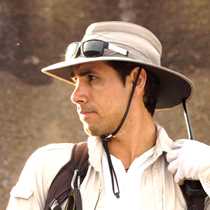After a night navigation of about four hours, we arrived to Santa Cruz Island, where we anchored at its harbor to start our different activities. We started with a visit to the Charles Darwin Research Station to learn about the conservation efforts to restore the populations of giant tortoises that nowadays are endangered due to human impact, as well as the harm caused by introduced plants and animals. This program involves collecting turtles eggs from the wild and taking them to the Station, where the will finish their incubation. After hatching, the young will stay at the corrals for about five to seven years until they grow enough to survive in the wild.
One example of the success of this program is the experience that took place in Espanola Island, where the only remaining individuals were collected in the late seventies, only twelve females and two males. In addition to this, scientists found another member from this population that was found in San Diego Zoo, and after all from these fifteen individuals, they reproduced more than three thousand tortoises that were repatriated back to their home location in Espanola Island. A very successful program!
After this visit, our guests had different options, like visiting the town of Puerto Ayora, or visiting a local school, or even going to a small farm where they observed the process of producing alcohol from sugar cane. We also watched their methods of squeezing the sugar cane with a help of a donkey, after which they store the sugar syrup for about two days in a special container for later. Eventually they will cook it until the vapors are condense to get the final product, which is a very strong alcohol with some seventy proof degrees--you can even like this stuff on fire!
On the way to our lunch, we passed through several farms where local people grow lots of crops and fruits, as far as the soil in the highlands is very rich in humus.
During the afternoon, we visited a private farm where giant tortoises dwell peacefully, they are not part of any breeding program but true wild individuals that survived the overhunting in the past hundreds of years. The visit also included a walk through a lava tunnel. These are formed when a huge lava flow occurs, a fiery river going downhill in which the upper part is in contact with the air, forming a solid crust on top but holding an still molten interior. When the lava flow decreases, there is no more material to fill in, so a hole is left behind and a lava tunnel is formed.
During all these visits we also saw a large variety of birds, like small and medium ground finches, a cattle egret, and a smooth-billed ani among others.
We made our way back on board the National Geographic Endeavour II, while some decided to stay a bit longer in town. We all enjoyed a wonderful sunset.








